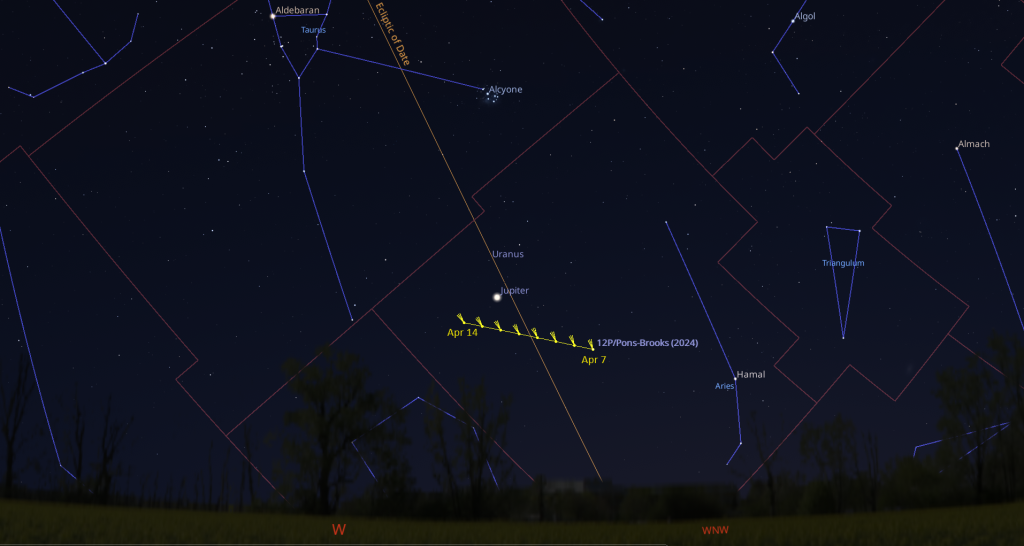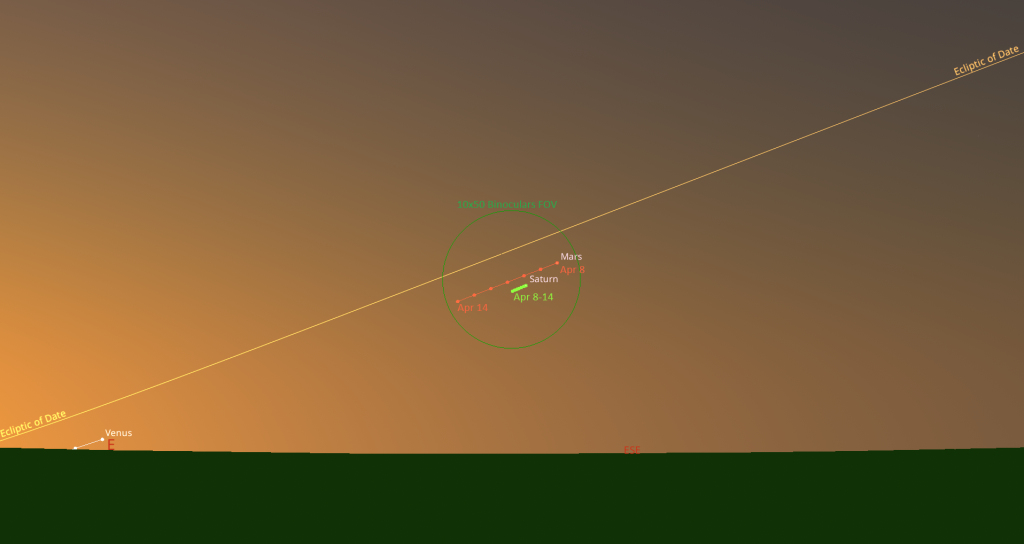The Solar Eclipse Hits and the Evening Moon Appears, Comet Pons-Brooks Passes Jupiter in Evening, and Morning Mars Kisses Saturn!

Kerry-Ann Lecky Hepburn captured this amazing shot of the August, 2017 partial solar eclipse.
Hello, Spring Stargazers!
Here are your Astronomy Skylights for the week of April 7th, 2024 by Chris Vaughan. Feel free to pass this along to your friends and send me your comments, questions, and suggested topics. You can also follow me on Twitter as @astrogeoguy! Unless otherwise noted, all times are expressed in Eastern Time. To subscribe to these emails please click this MailChimp link.
If you’d like me to bring my Digital Starlab portable inflatable planetarium to your school or other daytime or evening event in Bruce, Grey and Simcoe Counties, or deliver a virtual session anywhere, contact me through AstroGeo.ca, and we’ll tour the Universe, or the Earth’s interior, together! My book with John A. Read entitled 110 Things to See With a Telescope is a guide to viewing the deep sky objects in the Messier List – for both beginners and seasoned astronomers. DM me to order a signed copy!
The moon passes in front of the sun for the solar eclipse on Monday, then our natural satellite will return to evening and pose for some photo ops. The relatively dark evenings will also be ideal for galaxy viewing and the sight of brightening Comet 12P/Pons-Brooks passing below bright Jupiter and faint Uranus in early evening. In the morning sky Mars will pass very close to Saturn and Venus will appear just before sunrise. Read on for your Skylights!
The Great North American Solar Eclipse
Last week I covered all the important aspects of tomorrow’s total/partial solar eclipse in great detail. You can find that material posted on AstroGeo.ca here. Fingers crossed that we all get sunny skies for it.
Several groups will be live streaming the eclipse on YouTube. The partial phase is rather slow, so you may wish to step through that part and focus on the minutes of totality, which will happen at different times across the continent.

The Moon
After the moon meets with the sun tomorrow, it will return to shine as a waxing crescent in the western sky after sunset. After the solar eclipse the moon will slide away from the sun by more than its own diameter each hour, so observers in Hawaii and Asia can already look for the extremely thin crescent of the young moon above the western horizon after sunset on Monday evening!
Tuesday’s still very slender crescent moon will resemble the Cheshire Cat’s smile when it shines near bright Jupiter and faint Uranus – setting up a wonderful widefield photo opportunity in the western sky after sunset. On Tuesday the moon will be below Jupiter. On Wednesday, they’ll be closer, with the moon to Jupiter’s upper right. Earthshine will brighten the moon on both evenings. Sometimes called the Ashen Glow or the Old Moon in the New Moon’s Arms, the phenomenon is visible within a day or two of new moon, when sunlight reflected off Earth and back toward the moon slightly brightens the unlit portion of the moon’s Earth-facing hemisphere. Once the sky darkens, look for the small dot of Uranus above Jupiter and Comet 12P/Pons-Brooks less than a binoculars’ field below Jupiter.
The brighter, more fulsome moon will shift from Aries (the Ram) and into Taurus’ pasture on Thursday. After dusk it’ll be halfway up the western sky and positioned above and between two jewels of Taurus. The bright little Pleiades star cluster, also known as Subaru, Matariki, the Hole in the Sky, the Seven Sisters and Messier 45, will be located to the moon’s lower right (or celestial west). The larger and sparser Hyades star cluster, which forms the triangular face of Taurus (the Bull), will twinkle off to the moon’s left. The bright planet Jupiter will shine below them. The scene will make another nice widefield photo if you can get the exposure just right.
The latter half of this week and most of next week will be the best time to view our natural satellite under magnification. Everyday binoculars and backyard telescopes will show the spectacular, lunar terrain alongside the curving, pole-to-pole terminator boundary. Each night the moon will be waxing in phase and highlighting new vistas to enjoy. The moon will conveniently rise during the afternoon and linger about an hour longer each night.
After spending Friday near Taurus’ horn tip star Elnath, the moon will charge toward Gemini (the Twins). High in the western sky on Sunday evening, April 14, the almost half-illuminated, waxing gibbous moon will shine below Gemini’s brightest stars Pollux (on the left) and Castor (on the right). As the night wears on, the moon’s eastward orbital motion will shift it closer to Pollux. All three will set around 2:45 am local time.
Comet Pons-Brooks
I’ve been updating everyone about a periodic comet named 12P/Pons-Brooks that is visible in the northwestern sky in early evening. The comet has brightened beyond magnitude 4.5, which is within reach of a small backyard telescope or good binoculars under dark skies – and possibly unaided eyes until the moon brightens later this week. The comet should continue to grow a bit brighter as it draws closer to the sun and warms further in later April. You may have heard this comet referred to as the “Devil Comet”, a silly clickbait name that is a leftover from last fall when the comet sprouted two jets of gas that made it resemble a horned head or the Millennium Falcon. It no longer looks that way.
For observers in mid-northern latitudes, the comet will continue to be located low in the western sky after dusk every night. The best combination of sky darkness and the comet’s height will be around 8:55 pm in your local time zone. Visually, expect to see a faint, fuzzy smudge that may look greenish in photographs and larger telescopes. Its faint tail, best seen in binoculars and long exposure photos, will extend upwards. The comet will drop below the treetops before 9:30 pm, so start looking as soon as the sky darkens.

This week, Comet Pons-Brooks will continue to travel right-to-left through Aries (the Ram) several finger widths below Jupiter. Tonight (Sunday) it will be positioned a palm’s width to the lower right of Jupiter (or 6 degrees to the celestial northwest) – in the direction towards bright star named Hamal. Each night after that the comet will slide farther away from Hamal and under Jupiter. It will pass directly under Jupiter on Friday – but the comet and bright planet will share the view in binoculars all week. Let me know if you see it!
The Planets
Jupiter will continue to be the very bright “star” shining above the western horizon after sunset every night – but its inexorable sunward drop each night due to Earth’s motion around the sun will soon find the planet embedded in twilight. In that situation, unaided eyes and binoculars will work the best. This week, Jupiter will set at about 10 pm local time. As I mentioned above, the waxing crescent moon will pose beside Jupiter on Tuesday and Wednesday, and periodic comet 12P/Pons-Brooks will be sliding under Jupiter.
Look for Jupiter’s four largest Galilean moons lined up beside the planet. Named Io, Europa, Ganymede, and Callisto in order of their orbital distance from Jupiter, those moons complete orbits of the planet every 1.7, 3.6, 7.2, and 16.7 days, respectively. If you see fewer than four moons, then one or more of them is crossing in front of or behind Jupiter, or hiding in Jupiter’s dark shadow – or two of the moons are very close together or occulting one another. The four moons and Jupiter will spread out like beads on a necklace on Wednesday evening.
Jupiter has been creeping closer to Uranus for some time. That magnitude 5.9 planet will need a darker sky before it shows up in your binoculars. Tonight (Sunday) it will be located only two finger widths above Jupiter. By next Sunday, that gap will shrink to one finger (or 1 degree). The two planets will be cozy enough to view together in a telescope all week long, but your optics might flip and/or mirror the view – so search in several directions from Jupiter for its blue-green speck.

The rest of the planets are either too close to the sun to see (Mercury) or in the eastern pre-dawn sky. Reddish Mars and yellowish Saturn, both about equally bright, will rise together around 5:30 am local time and then climb until the morning twilight hides them. The two planets will be cozy enough to share the view in binoculars from now to April 18, and telescope-close from Tuesday to Friday – though they will swap sides over that period. Turn all optics away from the eastern horizon before the sun rises. The severely tilted morning ecliptic will keep the planets low in a brightening sky, but observers living closer to the tropics, where the ecliptic will stand upright, will have a much easier view.
Venus is rising shortly before the sun every morning. It will meet the sun at solar conjunction in early June. For now, at mid-northern latitudes Venus will rise at about 6:15 am local time, but you may need to walk around to position the planet between trees or buildings.
Public Astronomy-Themed Events
Every Monday evening, York University’s Allan I. Carswell Observatory runs an online star party – broadcasting views from four telescopes/cameras, answering viewer questions, and taking requests! Details are here. They host in-person viewing on the first clear Wednesday night each month. Other Wednesdays they stream views online via the observatory YouTube channel. Details are here.
Eastern GTA sky watchers are invited to join the RASC Toronto Centre and Durham Skies for solar observing and stargazing at the edge of Lake Ontario in Millennium Square in Pickering on Friday evening, April 12, starting at 6 pm. Details are here. Before heading out, check the RASCTC home page for a Go/No-Go call – in case it’s too cloudy to observe.
Spend some time in the other dome at the David Dunlap Observatory! On Saturday, April 20, you can join me in my Starlab Digital Planetarium for an interactive journey through the Universe at DDO. We’ll tour the night sky and see close-up views of galaxies, nebulas, and star clusters, view our Solar System’s planets and alien exo-planets, land on the moon, Mars – or the Sun, travel home to Earth from the edge of the Universe, hear indigenous starlore, and watch immersive fulldome movies! Ask me your burning questions, and see the answers in a planetarium setting – or sit back and soak it all in. Please note that all guests will sit on a clean floor. A registered adult must accompany all registered participants under the age of 16. We run sessions geared to junior astronomers in the morning and family sessions at 1 pm and another at 2:45 pm. Registration is required. More information and the registration links are here.
Space Station Flyovers
There are no good opportunities to see the ISS (the International Space Station) gliding silently over the Greater Toronto Area this week.
Keep your eyes on the skies! I love getting questions and requests. Send me some!